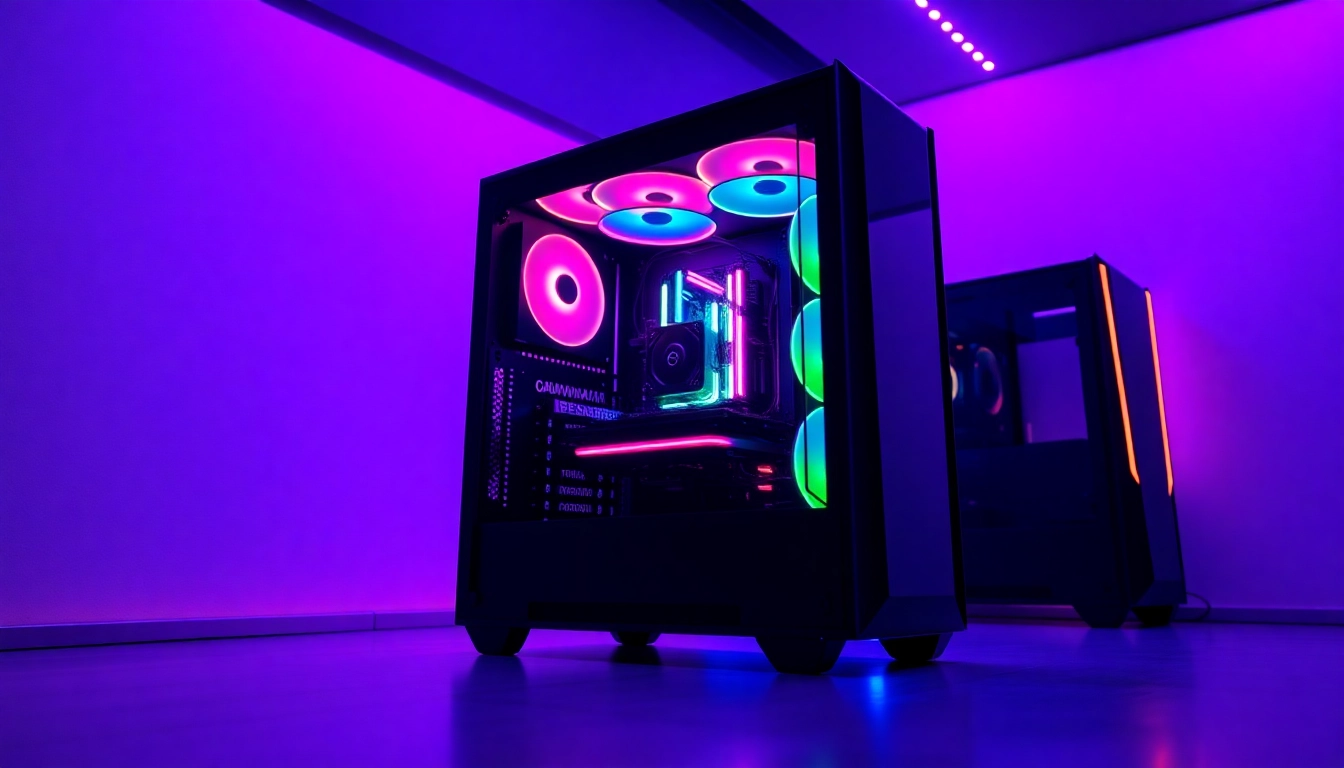Understanding DMA Firmware Basics
What is DMA Firmware?
Direct Memory Access (DMA) firmware is a critical component that enables devices to communicate directly with the computer’s memory without the intervention of the CPU. This functionality dramatically increases data transfer rates and allows for more efficient processing capabilities in various applications, including video gaming and high-performance computing environments. The specific firmware programs the DMA-enabled hardware components to effectively manage memory operations, and it plays a vital role in ensuring seamless communication between devices and the CPU. Using dma firmware significantly enhances the performance and efficiency of computer systems, especially in real-time data processing scenarios.
Key Features of DMA Firmware
DMA firmware typically encompasses several vital features:
- Reduced CPU Load: By allowing devices to transfer data directly to and from memory, DMA firmware alleviates the processing burden on the CPU, enabling smoother multitasking and efficient resource utilization.
- High-speed Data Transfer: DMA facilitates rapid data movement between peripherals and memory, outperforming traditional interrupt-driven methods. This is especially crucial in data-intensive applications.
- Support for Various Protocols: DMA firmware often supports multiple communication protocols, making it adaptable for various devices and systems.
- Error Checking: Many DMA firmware implementations include built-in error detection mechanisms to ensure data integrity during transfers.
Common Uses in Technology
The applications of DMA firmware are numerous and varied. Commonly found in computing systems, it is essential in:
- Gaming: Real-time online games require fast data exchanges to maintain responsiveness and performance. DMA-enabled hardware ensures a smooth gaming experience with minimal latency.
- Video Editing: Professional video editing and processing tools rely on DMA firmware for high-speed data access, enabling users to edit videos without lag.
- Networking: DMA technology is integral in network interface cards (NICs) for efficient data packet transfers over network connections.
- I/O Operations: Any situation requiring rapid input/output operations, such as data acquisition systems, benefits significantly from DMA firmware.
Getting Started with DMA Firmware Development
Essential Tools and Requirements
To get started with developing and customizing DMA firmware, one needs to gather essential tools and resources:
- Development Environment: A robust IDE (Integrated Development Environment) tailored for firmware development is necessary to facilitate coding, debugging, and testing. Examples include Eclipse, Keil, or similar environments.
- Hardware: A compatible DMA-enabled device, such as a DMA card or development board, is required to test and deploy the firmware.
- Documentation and Specifications: Access to the hardware documentation and DMA specifications will guide the development process.
- Debugging Tools: Utility tools for monitoring signals and checking outputs are vital to troubleshoot issues effectively during development.
Setting Up Your Development Environment
Once you have gathered the necessary tools, the next step involves establishing your development environment. Here’s a step-by-step guide:
- Install the preferred IDE suitable for your coding language.
- Configure the IDE for your hardware platform, ensuring it recognizes the DMA device.
- Integrate any additional libraries or toolchains needed for DMA firmware development.
- Set up version control (like Git) to manage your code effectively throughout the development process.
Basic Coding Techniques for DMA Firmware
Understanding the coding techniques relevant to DMA firmware development is crucial for creating efficient code. Some basic techniques include:
- Memory Mapping: Understand how to map the device’s memory for optimal access.
- Interrupt Handling: Implement strategies to manage interrupts efficiently, especially when integrating with other components.
- Direct Memory Operations: Use direct memory commands to streamline data transfer processes without CPU involvement.
Advanced DMA Firmware Concepts
Customizing DMA Firmware for Specific Applications
The customization of DMA firmware allows developers to optimize functionality for specific applications. Key considerations include:
- Application Needs: Identify the precise requirements of your application to tailor the firmware accordingly—deciding on data transfer rates, interrupt-driven versus continuous transfer modes, and error handling systems.
- Performance Tuning: Continuously profile and test the firmware performance in your specific use case to make necessary adjustments that improve speed and efficiency.
- Compatibility Checks: Ensure that your customized firmware remains compatible with diverse system architectures and hardware components.
Integrating with Hardware Components
Integrating DMA firmware involves interacting directly with hardware components, which require a comprehensive understanding of their functionalities:
- Peripheral Interfaces: Learn how your DMA card interfaces with various peripheral devices to manage communication protocols effectively.
- Signal Handling: Understand how to interpret control signals that dictate when and how data transfers are executed.
- Power Management: Implementing efficient power management techniques is critical, especially for battery-operated devices.
Troubleshooting Common Issues
Troubleshooting is an integral part of the firmware development lifecycle. Frequent issues might include:
- Data Loss: If data is lost during transfers, ensure that your error handling and checking mechanisms are highly effective.
- Integration Problems: If components do not communicate as expected, verify the compatibility and configurations of your DMA card.
- Performance Bottlenecks: Use diagnostic tools to identify slow data transfers and optimize code accordingly.
Security Considerations in DMA Firmware
Understanding Vulnerabilities
With the convenience of DMA comes the potential for security vulnerabilities that can expose systems to threats:
- Unauthorized Access: As DMA allows direct memory access, it can inadvertently provide unauthorized users a means to manipulate data.
- Exploiting DMA Channels: Malicious actors can craft attacks by exploiting DMA channels, gaining access to sensitive information.
- Firmware Tampering: Attackers can modify firmware to create backdoors for accessing systems.
Best Practices for Secure Firmware
To enhance the security of DMA firmware, consider implementing the following best practices:
- Access Controls: Establish robust access controls to limit who can implement changes to DMA settings and firmware configurations.
- Regular Updates: Regularly update your firmware to patch security vulnerabilities and enhance performance features.
- Code Audits: Perform regular audits of your code, focusing on security risks associated with DMA.
Impact of Anti-Cheat Measures
With the growing use of DMA in gaming, the presence of robust anti-cheat measures cannot be overlooked:
- Understanding Anti-Cheat Technologies: Research various anti-cheat systems employed in gaming communities to build firmware that adheres to their security protocols.
- Designing for Anti-Cheat Prevention: Ensure that the design includes mechanisms to evade detection by anti-cheat systems without compromising performance.
- Community Compliance: Stay updated with community standards and ensure your customized firmware complies with these to avoid bans or penalties.
Future Trends in DMA Firmware Development
Evolving Technologies and Standards
The landscape of DMA firmware development is continually evolving, with new technologies and standards emerging:
- AI Integration: The application of artificial intelligence in firmware development promises advanced functionalities for predictive operations and error detection.
- Increased Automation: As automation in data processing grows, DMA firmware will play an essential role in streamlining operations across connected devices.
- Standardization: Ongoing efforts to standardize protocols and practices around DMA firmware will foster wider industry compliance and interoperability.
Predictions for DMA Firmware Applications
Looking ahead, DMA firmware will likely see expanded applications in diverse fields:
- Healthcare: Real-time patient monitoring systems will utilize DMA firmware to ensure the rapid transfer of critical health data.
- Smart Cities: DMA will support the real-time data transfer needed for smart city applications, enhancing traffic management and energy distribution systems.
- Cybersecurity: As security threats evolve, DMA firmware will adapt to provide enhanced protective measures against unauthorized access.
Preparing for the Next Generation of DMA Firmware
To stay relevant in the fast-paced world of technology, developers should focus on:
- Continuous Learning: Stay informed about new developments and techniques in DMA firmware technology.
- Collaboration: Engage with other developers and stakeholders in the community to share knowledge and resources.
- Flexibility: Be prepared to adapt your firmware solutions according to emerging trends and user needs.



